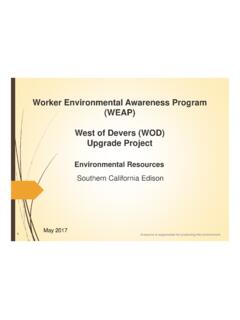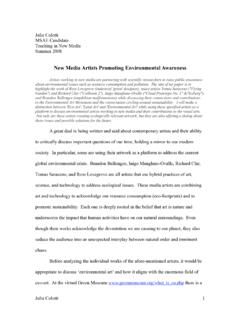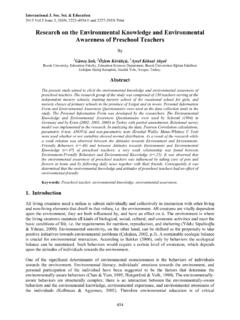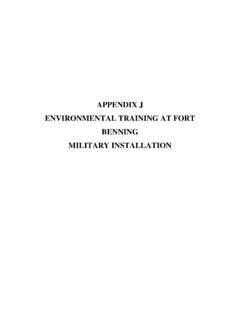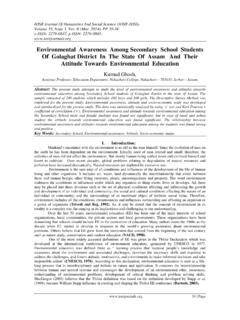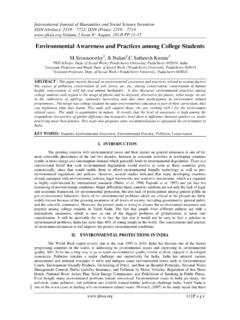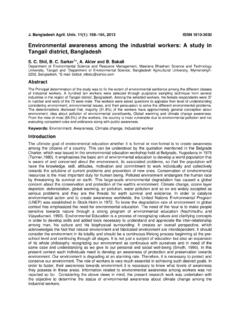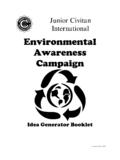Transcription of AGI Environmental Awareness Series, 5
1 [Aristotle attributed this teaching to Thales of Miletus, the first known Greek philosopher, scientist, and mathematician. Thales lived from approximately 624-546 ]Publishing PartnersAGI gratefully acknowledges thefollowing organizations for theirsupport of this book and the poster,Water The Essential Resource. A list of other titles in the AGIE nvironmental Awareness Seriesand information on ordering thesepublications appears on page of ReclamationNational Park Army Corps of EngineersUSDA Forest Service Geological SurveyAGI Environmental Awareness Series, 5 Stephen J. VandasThomas C. WinterWilliam A. BattaglinWith a Foreword byPhilip E. LaMoreauxAmerican Geological Institutein cooperation withBureau of Reclamation, National Park Service, Army Corps of Engineers, USDA Forest Service, Geological Survey2 About the AuthorsStephen J. Vandas,a hydrologist with the Geological Survey, received a in WatershedSciences from Colorado State University in 1975.
2 He has also worked as a hydrologist for the of Reclamation and the Bureau of Land Management. His work has included reservoiroperation and irrigation scheduling studies, Environmental studies involving instream flow, wildernesswater rights, oil-shale development, and Colorado River Basin salinity. His most recent project hasbeen the development of water-education materials. Thomas C. Winter,a Senior Research Hydrologist with the Geological Survey in Denver, received , , and degrees in Geology from the University of Minnesota. In 2002, Winterreceived the Meinzer Award, the highest honor in the field of hydrogeology in the nation, from theHydrogeology Division of the Geological Society of America. Following 12 years of conducting waterresources assessments in Minnesota, he has conducted research since 1973 on the hydrology of lakesand wetlands, with emphasis on their relation to groundwater. He helped initiate and has been aprincipal investigator at long-term field research sites in New Hampshire, Minnesota, North Dakota, and Nebraska since the late A.
3 Battaglinreceived a in Geology from the University of Colorado, Boulder, in 1984, and a in Geological Engineering, from Colorado School of Mines, in 1992. He has worked as a hydrologist for the U. S. Geological Survey, Water Resources Division since 1985. He is currentlyworking on studies that use geographic information systems and statistics to investigate the fate andtransport of nutrients and agricultural chemicals in water resources of the midwestern United Geological Institute4220 King StreetAlexandria, VA 22302(703) American Geological Institute (AGI) is a nonprofit federation of 40 scientific and professional asso-ciations that represent more than 120,000 geologists, geophysicists, and other Earth scientists. Foundedin 1948, AGI provides information services to geoscientists, serves as a voice of shared interests in theprofession, plays a major role in strengthening geoscience education, and strives to increase publicawareness of the vital role the geosciences play in mankind s use of resources and interaction with theenvironment.
4 The Institute also provides a public-outreach web site, purchase additional copies of this book or receive an AGI publications catalog please contact AGI by mail or telephone, send an e-mail request to or visit the online bookstore Copyright 2002 by American Geological InstituteAll rights : 0-922152-63-2 Design: De Atley DesignProject Management: Julia A. Jackson, GeoWorksPrinting: CLB PrintingAGI Environmental Awareness SeriesGroundwater PrimerSustaining Our Soils and SocietyMetal Mining and the EnvironmentLiving with Karst A Fragile FoundationWater and the Environment3 Contents2314 Foreword 4 Preface 5It Helps to Know 7 Environmental Concerns 9 Why Water Is Important 10 Where Water Is Located 11 About Water Use 12 How Water Resources are Managed 13 Water Basics 17 The Water Cycle 17 Water in the Atmosphere 18 Surface Water 20 Groundwater 23 Surface Water and Groundwater Relations 26 Floods 26 Droughts 28 Natural Water Quality 28 Environmental Concerns 31 Surface-Water Management 31 Storage in Reservoirs 32 Controlled Release 33 Diversions 35 Groundwater Withdrawals 37 Depletion 37 Land Subsidence 37 Salt-water Intrusion 38 Changes in Land and Water Use 38 Effects of Floods 41 Effects of Droughts 41 Water Quality 42 Sediment and
5 Natural Organic Materials 43 Nutrients 43 Bacteria 44 Toxic Substances 44 Effect of Contaminants on Water Quality 45 Protecting Our Water Resources 49 Water Management 49 Conservation 50 Water Quality Standards 51 Preventing Contamination 52 Water Treatment 52 Water Rights 53 Protective Laws and Regulations 54 Providing for the Future 55 Glossary 58 Credits 59 References 60 Sources of Additional Information 61 State Geological Surveys 62 Index 63 AGI Foundation 644 ForewordWithin our Solar System, Earth is known as the water planet,and water is an absolute requirement of life. On our planet, the most controlling resource is water not oil or minerals but water. Its distribution, quantity, availability, and quality are the controls for thedevelopment of agriculture, industry, rural, urban, and municipal use. The water-rich areas of the world are truly the richest places on the United States, approximately one third of the water diverted from streams or pumped fromgroundwater is used annually for the irrigation of crops.
6 Almost as much water is diverted from streams forthermoelectric power generation. (However, approximately 61 percent of the water diverted for irrigation isused by crops, while only percent of the water diverted for thermoelectric power is consumed at powerplants.) It takes 15,000 gallons to build the average automobile and that does not include the water used inmaking the steel that goes into them. It takes about another 20 gallons of water to produce each gallon ofgasoline. Flushing toilets and running water for appliances, such as air conditioners, dishwashers, andwashing machines, usse billions of gallons more annually. There would be little objection to many wasteful uses of water if fresh water of good quality wereunlimited, however, the sad fact is that it is not. Only about 3 percent of the total water in the world isfresh water, and most of that is locked in ice caps and glaciers. Just a fraction of Earth s water about percent is accessible fresh water, and approximately 98 percent of this amount is stored asgroundwater.
7 The rest is water in streams and lakes, stored in the soil, and in the atmosphere. All of thewater on Earth, salty and fresh, is part of the hydrologic cycle that must be studied in great detail locallyand worldwide to provide the data needed to properly develop and manage this most valuable information is needed so that our water resources can be used wisely. We have learned thatmismanagement of our water resources will bring on one water crisis after another. This EnvironmentalAwareness Series publication is intended to give the general public, educators, and policy makersinformation related to water resources and supplies. The American Geological Institute produces this Seriesin cooperation with its 40 Member Societies and others to provide a non-technical geoscience frameworkconsidering Environmental questions. Water and the Environmentwas prepared under the sponsorship ofthe AGI Environmental Geoscience Advisory Committee with the support of the AGI Foundation and thepublishing partners listed on the inside front E.
8 LaMoreauxChair, AGI Environmental Geoscience Advisory Committee, 1993 present5 PrefaceWhen we turn the faucet on we expect clean water to come out,24 hours a day, seven days a week. Our expectations are so high that we have built large dams andassociated reservoirs, pumped large quantities of groundwater from aquifers, and constructed intricatewater distribution systems to transport water from areas where it is located to where we prefer to live. We monitor the quality of our water and spend billion of dollars to treat it. In the United States, we have come to rely on good quality water and plenty of it; after all, water isessential to life. As a society, we depend upon water for many uses including irrigation, power generation,recreation, and transportation. But what happens when there is a drought, or even times when the supplyof water is less than what we have become accustomed to? Or maybe there is too much water and itfloods our home, farm, or city.
9 What if the quality of our water is degraded and we can no longer use it for a desired purpose, or what if a dam is built across our favorite river or stream, changing itscharacteristics? How do natural or human-induced changes to water affect our lives as well as the plants and animals that also depend upon it for existence?This publication provides information about water, its importance, where itcomes from, water-related Environmental concerns, water protection, policesand regulations, and our future needs for water. We greatly appreciate thecontributions of many individuals; without their assistance this publica-tion would not have been possible. Special thanks to Liz Ciganovich,John Evans, Robert Olstead, Edward Swibas, Elaine Simonson, andMargo VanAlstine for providing figures and photos and to John Flager,Lee Gerhard, Jack Hess, Phil LaMoreaux, Travis Hudson, MarcusMilling, Dennis Block, James Gauthier-Warinner, Steve Glasser, JamesComiskey, Shannon Cunniff, Joseph Keely, John Keith, John Moore, MarkMcCaffrey, Jim Washburne, M.
10 Gordon (Reds) Wolman, Thomas La Point,and James McGonigle for reviewing the manuscript. Also, we gratefullyacknowledge the editorial assistance of Julie Jackson, and the superb graphicdesign by Julie De Atley. Finally, we would like to acknowledge the American GeologicalInstitute for the opportunity to produce this publication, and the Geological Survey, Forest Service, Bureau of Reclamation, Army Corp of Engineers, and National Park Service for their support of Water and the Environment. So pour a glass of water and read J. VandasThomas C. WinterWilliam A. BattaglinNovember, 20026 Greer Spring, Mark Twain National Forest, Missouri7is the only one in our solar system presentlycharacterized and shaped by abundant liquidwater a necessity for life. This vital resourcemakes up 60 percent of the human body. A person can live no more than 4 to 5 dayswithout water, and we rely on it for drinking,cooking, bathing, washing clothes, growingfood, recreation, industry, and mining, as well as generation of electric power.

